Abstract
Mycoplasma spp., sterol and fatty acid auxotrophs, are conventionally grown in complex media containing high concentrations of serum. Serum supplies the required lipids, but its presence complicates studies on the metabolism and antigenicity of mycoplasmas as well as the membrane dynamics of these organisms. In the present work, fetal bovine serum was replaced with dilipidated albumin and liposomes containing high concentrations of cholesterol. The liposomes were produced from phosphatidylcholine which contained other lipid species, including phosphatidylethanolamine, phosphatidylglycerol, and cholesterol. Other liposomes containing cholesterol and one phospholipid yielded significantly less growth of Mycoplasma gallisepticum, indicating that several phospholipids are required to achieve growth levels comparable to those obtained with complex medium. The sources and concentrations of cholesterol, albumin, phosphatidylcholine, and other phospholipids and the interactions among them were important affectors of mycoplasmal growth. Optimal lipid and albumin conditions established for M. gallisepticum were then used to propagate five diverse Mycoplasma spp. to growth levels which equalled or surpassed those obtained with medium containing 17% fetal bovine serum.
Full text
PDF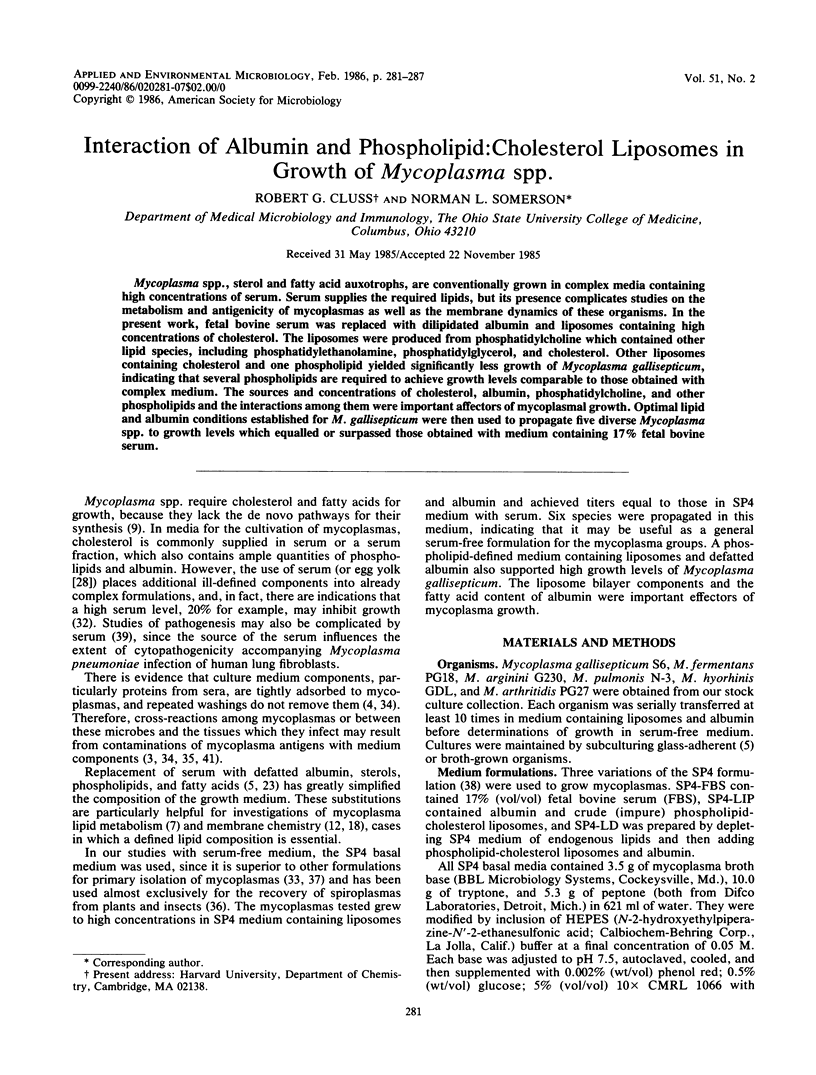

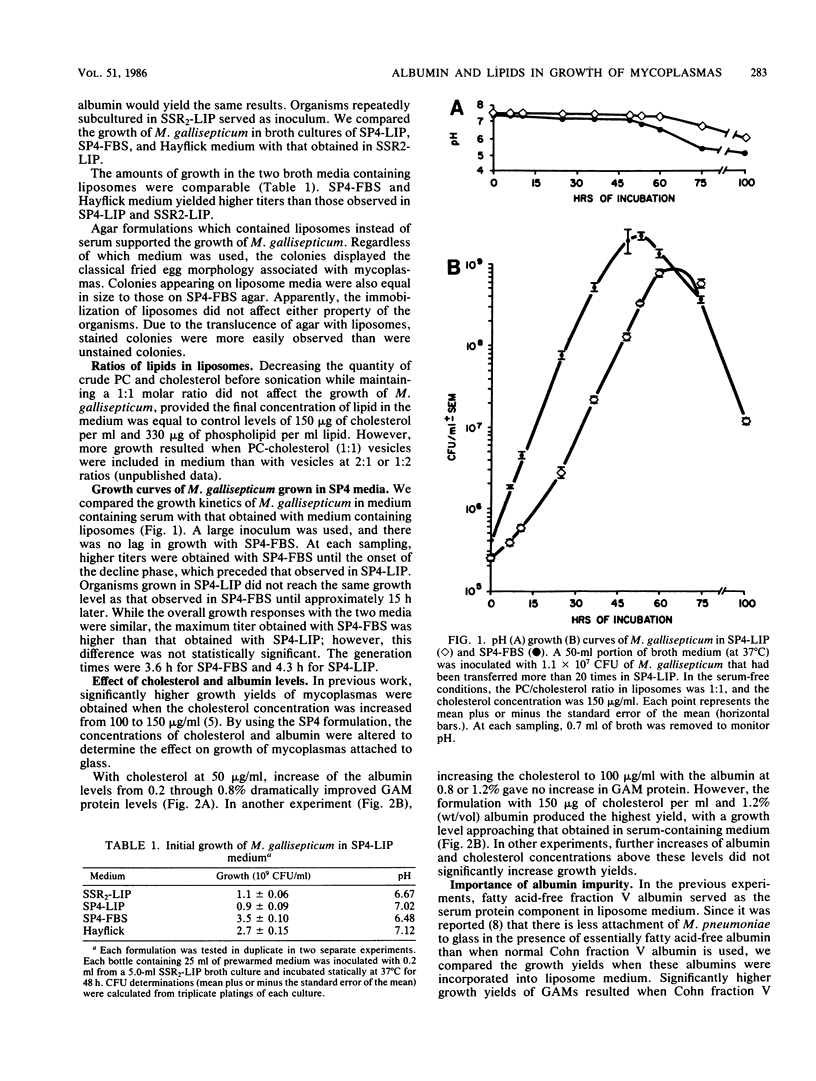
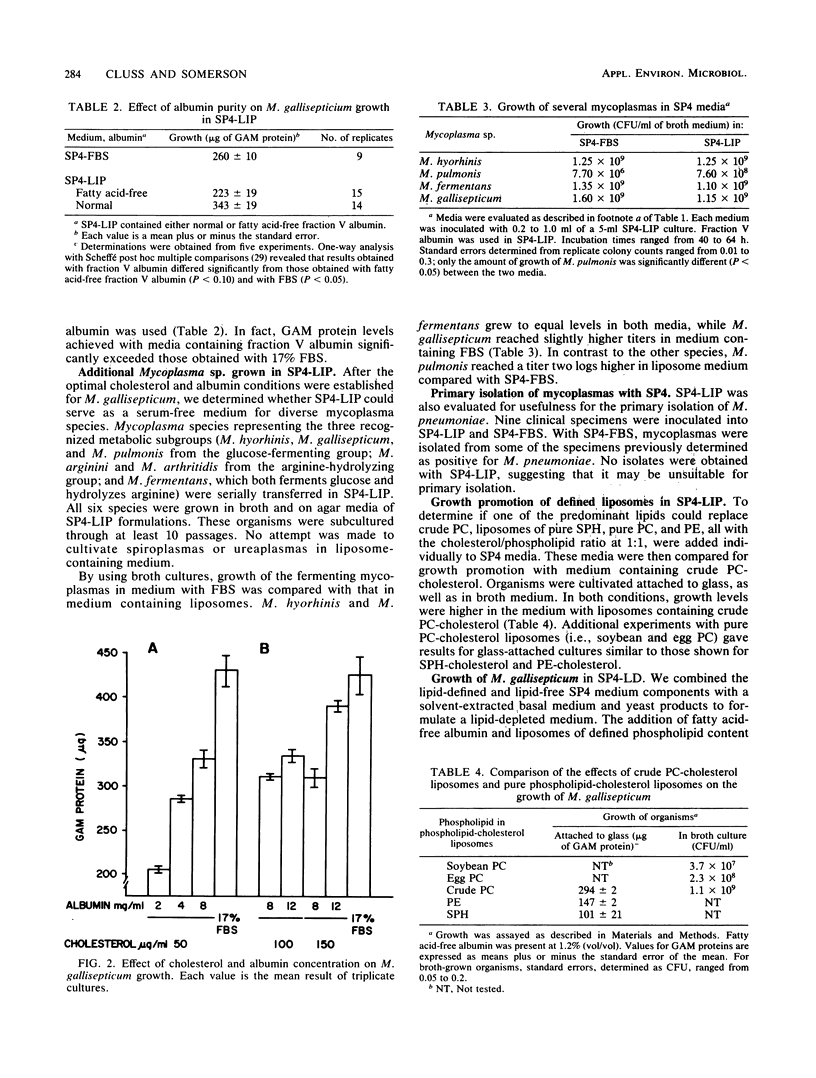
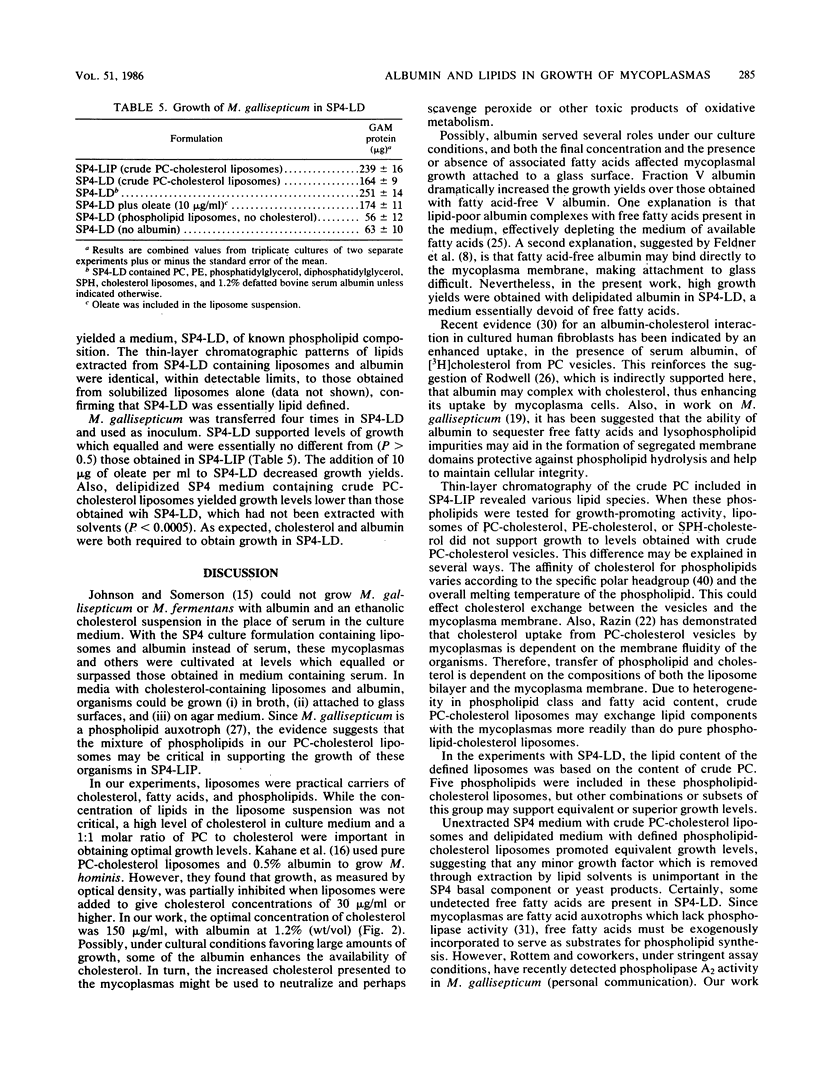
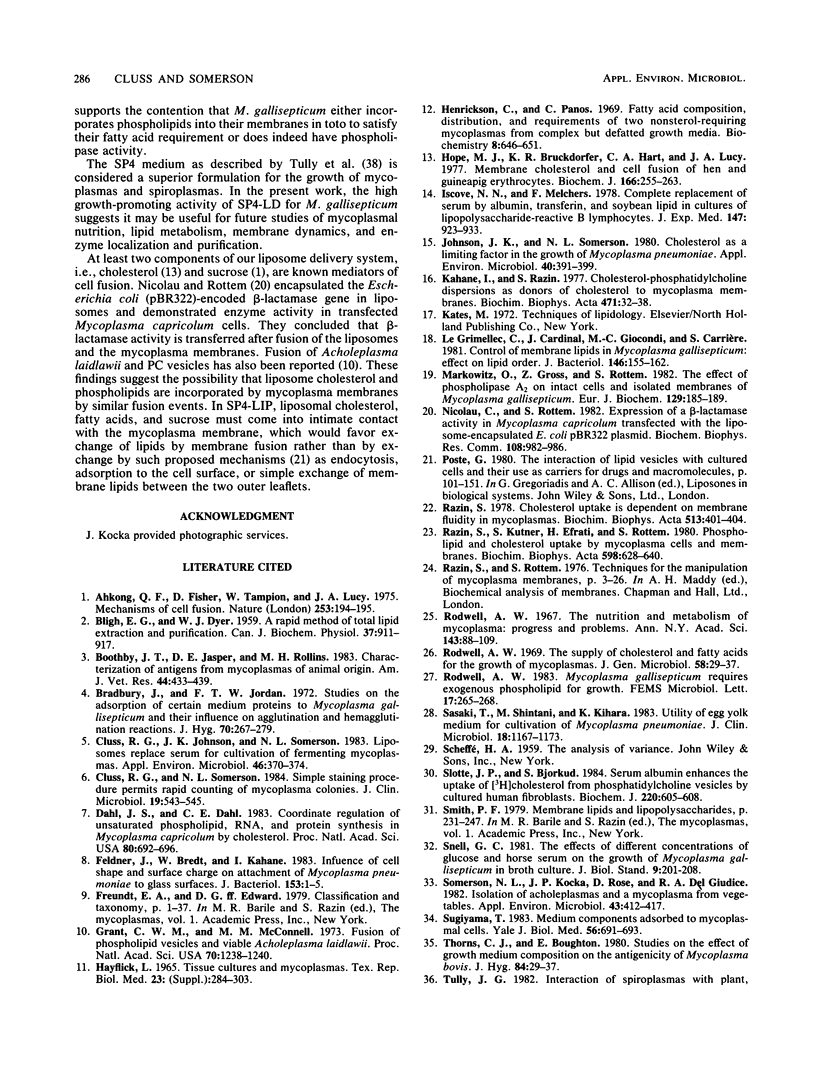
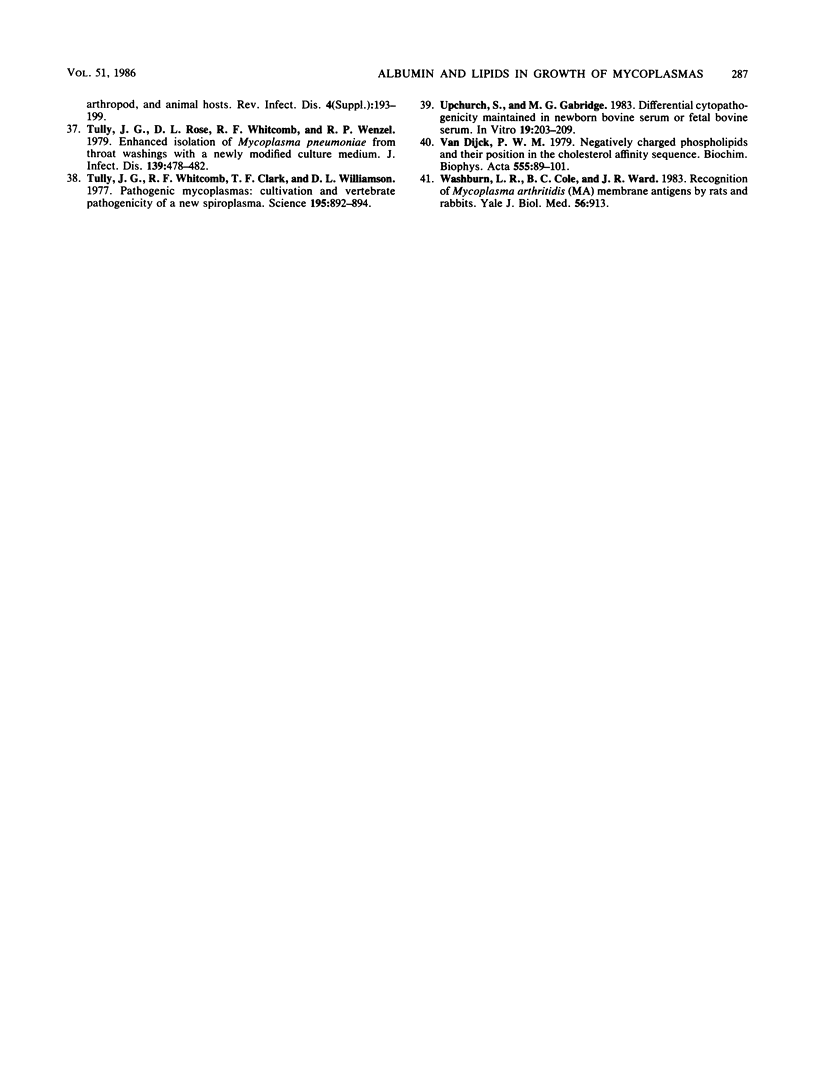
Selected References
These references are in PubMed. This may not be the complete list of references from this article.
- Ahkong Q. F., Fisher D., Tampion W., Lucy J. A. Mechanisms of cell fusion. Nature. 1975 Jan 17;253(5488):194–195. doi: 10.1038/253194a0. [DOI] [PubMed] [Google Scholar]
- BLIGH E. G., DYER W. J. A rapid method of total lipid extraction and purification. Can J Biochem Physiol. 1959 Aug;37(8):911–917. doi: 10.1139/o59-099. [DOI] [PubMed] [Google Scholar]
- Boothby J. T., Jasper D. E., Rollins M. H. Characterization of antigens from mycoplasmas of animal origin. Am J Vet Res. 1983 Mar;44(3):433–439. [PubMed] [Google Scholar]
- Bradbury J. M., Jordan F. T. Studies on the adsorption of certain medium proteins to Mycoplasma gallisepticum and their influence on agglutination and haemagglutination reactions. J Hyg (Lond) 1972 Jun;70(2):267–278. doi: 10.1017/s0022172400022324. [DOI] [PMC free article] [PubMed] [Google Scholar]
- Cluss R. G., Johnson J. K., Somerson N. L. Liposomes replace serum for cultivation of fermenting mycoplasmas. Appl Environ Microbiol. 1983 Aug;46(2):370–374. doi: 10.1128/aem.46.2.370-374.1983. [DOI] [PMC free article] [PubMed] [Google Scholar]
- Cluss R. G., Somerson N. L. Simple staining procedure permits rapid counting of mycoplasma colonies. J Clin Microbiol. 1984 Apr;19(4):543–545. doi: 10.1128/jcm.19.4.543-545.1984. [DOI] [PMC free article] [PubMed] [Google Scholar]
- Dahl J. S., Dahl C. E. Coordinate regulation of unsaturated phospholipid, RNA, and protein synthesis in Mycoplasma capricolum by cholesterol. Proc Natl Acad Sci U S A. 1983 Feb;80(3):692–696. doi: 10.1073/pnas.80.3.692. [DOI] [PMC free article] [PubMed] [Google Scholar]
- Feldner J., Bredt W., Kahane I. Influence of cell shape and surface charge on attachment of Mycoplasma pneumoniae to glass surfaces. J Bacteriol. 1983 Jan;153(1):1–5. doi: 10.1128/jb.153.1.1-5.1983. [DOI] [PMC free article] [PubMed] [Google Scholar]
- Grant C. W., McConnell H. M. Fusion of phospholipid vesicles with viable Acholeplasma laidlawii. Proc Natl Acad Sci U S A. 1973 Apr;70(4):1238–1240. doi: 10.1073/pnas.70.4.1238. [DOI] [PMC free article] [PubMed] [Google Scholar]
- Henrikson C. V., Panos C. Fatty acid composition, distribution, and requirements of two nonsterol-requiring mycoplasmas from complex but defatted growth media. Biochemistry. 1969 Feb;8(2):646–651. doi: 10.1021/bi00830a028. [DOI] [PubMed] [Google Scholar]
- Hope M. J., Bruckdorfer K. R., Hart C. A., Lucy J. A. Membrane cholesterol and cell fusion of hen and guinea-pig erythrocytes. Biochem J. 1977 Aug 15;166(2):255–263. doi: 10.1042/bj1660255. [DOI] [PMC free article] [PubMed] [Google Scholar]
- Iscove N. N., Melchers F. Complete replacement of serum by albumin, transferrin, and soybean lipid in cultures of lipopolysaccharide-reactive B lymphocytes. J Exp Med. 1978 Mar 1;147(3):923–933. doi: 10.1084/jem.147.3.923. [DOI] [PMC free article] [PubMed] [Google Scholar]
- Johnson J. K., Somerson N. L. Cholesterol as a limiting factor in the growth of Mycoplasma pneumoniae. Appl Environ Microbiol. 1980 Aug;40(2):391–399. doi: 10.1128/aem.40.2.391-399.1980. [DOI] [PMC free article] [PubMed] [Google Scholar]
- Kahane I., Razin S. Cholesterol-phosphatidylcholine dispersions as donors of cholesterol to Mycoplasma membranes. Biochim Biophys Acta. 1977 Nov 15;471(1):32–38. doi: 10.1016/0005-2736(77)90390-x. [DOI] [PubMed] [Google Scholar]
- Le Grimellec C., Cardinal J., Giocondi M. C., Carrière S. Control of membrane lipids in Mycoplasma gallisepticum: effect on lipid order. J Bacteriol. 1981 Apr;146(1):155–162. doi: 10.1128/jb.146.1.155-162.1981. [DOI] [PMC free article] [PubMed] [Google Scholar]
- Markowitz O., Gross Z., Rottem S. The effect of phospholipase A2 on intact cells and isolated membranes of Mycoplasma gallisepticum. Eur J Biochem. 1982 Dec;129(1):185–189. doi: 10.1111/j.1432-1033.1982.tb07038.x. [DOI] [PubMed] [Google Scholar]
- Nicolau C., Rottem S. Expression of a beta-lactamase activity in Mycoplasma capricolum transfected with the liposome-encapsulated E.coli pBR 322 plasmid. Biochem Biophys Res Commun. 1982 Oct 15;108(3):982–986. doi: 10.1016/0006-291x(82)92096-4. [DOI] [PubMed] [Google Scholar]
- Razin S. Cholesterol uptake is dependent on membrane fluidity in mycoplasmas. Biochim Biophys Acta. 1978 Nov 16;513(3):401–404. doi: 10.1016/0005-2736(78)90208-0. [DOI] [PubMed] [Google Scholar]
- Razin S., Kutner S., Efrati H., Rottem S. Phospholipid and cholesterol uptake by Mycoplasma cells and membranes. Biochim Biophys Acta. 1980 Jun 6;598(3):628–640. doi: 10.1016/0005-2736(80)90042-5. [DOI] [PubMed] [Google Scholar]
- Rodwell A. W. The nutrition and metabolism of mycoplasma: Progress and problems. Ann N Y Acad Sci. 1967 Jul 28;143(1):88–109. doi: 10.1111/j.1749-6632.1967.tb27649.x. [DOI] [PubMed] [Google Scholar]
- Rodwell A. W. The supply of cholesterol and fatty acids for the growth of mycoplasmas. J Gen Microbiol. 1969 Sep;58(1):29–37. doi: 10.1099/00221287-58-1-29. [DOI] [PubMed] [Google Scholar]
- Sasaki T., Shintani M., Kihara K. Utility of egg yolk medium for cultivation of Mycoplasma pneumoniae. J Clin Microbiol. 1983 Nov;18(5):1167–1173. doi: 10.1128/jcm.18.5.1167-1173.1983. [DOI] [PMC free article] [PubMed] [Google Scholar]
- Slotte J. P., Björkerud S. Serum albumin enhances the uptake of [3H]cholesterol from phosphatidylcholine vesicles by cultured human fibroblasts. Biochem J. 1984 Jun 1;220(2):605–608. doi: 10.1042/bj2200605. [DOI] [PMC free article] [PubMed] [Google Scholar]
- Snell G. C. The effects of different concentrations of glucose and horse serum on the growth of Mycoplasma gallisepticum in broth culture. J Biol Stand. 1981;9(2):201–208. doi: 10.1016/s0092-1157(81)80024-8. [DOI] [PubMed] [Google Scholar]
- Somerson N. L., Kocka J. P., Rose D., Del Giudice R. A. Isolation of acholeplasmas and a mycoplasma from vegetables. Appl Environ Microbiol. 1982 Feb;43(2):412–417. doi: 10.1128/aem.43.2.412-417.1982. [DOI] [PMC free article] [PubMed] [Google Scholar]
- Sugiyama T. Medium components adsorbed to mycoplasmal cells. Yale J Biol Med. 1983 Sep-Dec;56(5-6):691–693. [PMC free article] [PubMed] [Google Scholar]
- Thorns C. J., Boughton E. Studies on the effect of growth medium composition on the antigenicity of Mycoplasma bovis. J Hyg (Lond) 1980 Feb;84(1):29–36. doi: 10.1017/s0022172400026486. [DOI] [PMC free article] [PubMed] [Google Scholar]
- Tully J. G., Rose D. L., Whitcomb R. F., Wenzel R. P. Enhanced isolation of Mycoplasma pneumoniae from throat washings with a newly-modified culture medium. J Infect Dis. 1979 Apr;139(4):478–482. doi: 10.1093/infdis/139.4.478. [DOI] [PubMed] [Google Scholar]
- Tully J. G., Whitcomb R. F., Clark H. F., Williamson D. L. Pathogenic mycoplasmas: cultivation and vertebrate pathogenicity of a new spiroplasma. Science. 1977 Mar 4;195(4281):892–894. doi: 10.1126/science.841314. [DOI] [PubMed] [Google Scholar]
- Upchurch S., Gabridge M. G. Differential cytopathogenicity accompanying Mycoplasma pneumoniae infection of human lung fibroblasts maintained in newborn bovine serum or fetal bovine serum. In Vitro. 1983 Mar;19(3 Pt 1):203–209. doi: 10.1007/BF02618060. [DOI] [PubMed] [Google Scholar]


